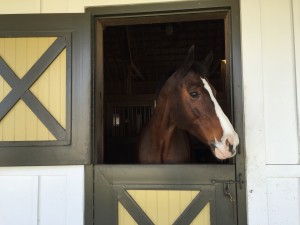Ventilation Options in the Stable
By Anna Hellman
A horse that cannot breathe well, cannot live well. As mentioned in the previous blog, good ventilation in your barn is crucial to the health and longevity of your horses. Today’s blog will cover the different types of ventilation options that can increase fresh airflow.
Ceilings: Horses require at least 1,600 square feet of air space so high ceilings allow hot air to rise. Hot air can be expelled by a fan, louver, or ridge vent. High ceilings keep the horses cool and create an open, airy environment.
Barn Doors: Properly placed barn doors allow for natural cross-ventilation. Especially during the summers, cross-ventilations can allow cool breezes to enter your barn and cool off your horses.
Stall Doors: Dutch stalls doors, stall guards, or stall doors with yolks or fold down features can greatly increase the amount of circulation. The problem with solid stall doors is that they block the flow of fresh air.
Windows: Windows also have the potential to allow natural cross-ventilation but can also create drafts. To prevent drafts, windows must be placed high, about 4-5 feet above the floor. Windows must also open at the top or be louvered.
Ridge Vents: Ridge vents are openings that are installed into the ridge of the roof. Ridge vents allow any stale or hot air to easily escape.
Exhaust Fans: Exhaust fans require electricity and can be expensive. Yet they drive out hot air and create a pressure difference that increases airflow. Exhaust fans also remove humidity. During the winter months when moisture levels are high, exhaust fans are valuable.
Stall Fans: When placed on each individual stall, they are useful on very hot days. They keep flies off your horses and create horizontal circulation. They must be placed cautiously so your horse cannot play with the fan or the electric cord.
Louvers: Louvers are slats that can be angled either horizontally or vertically within a frame. They can be installed in a variety of ways. They are commonly installed into walls, gables or eaves. They are beneficial because they direct incoming air upwards. Louvers also allow stale air to exit.
These are the most basic ventilation options. There are more complex, high-tech ventilation systems that are very interesting as well!
-
Articles
- December 2024
- November 2024
- October 2024
- September 2024
- August 2024
- July 2024
- June 2024
- May 2024
- April 2024
- March 2024
- February 2024
- January 2024
- December 2023
- November 2023
- October 2023
- September 2023
- August 2023
- July 2023
- June 2023
- May 2023
- April 2023
- March 2023
- February 2023
- December 2022
- November 2022
- October 2022
- September 2022
- August 2022
- July 2022
- June 2022
- May 2022
- April 2022
- March 2022
- February 2022
- January 2022
- December 2021
- November 2021
- October 2021
- September 2021
- August 2021
- July 2021
- May 2021
- April 2021
- March 2021
- February 2021
- January 2021
- December 2020
- November 2020
- October 2020
- September 2020
- August 2020
- July 2020
- June 2020
- May 2020
- April 2020
- March 2020
- February 2020
- January 2020
- December 2019
- November 2019
- October 2019
- September 2019
- August 2019
- July 2019
- June 2019
- May 2019
- April 2019
- March 2019
- February 2019
- January 2019
- December 2018
- November 2018
- October 2018
- September 2018
- August 2018
- July 2018
- June 2018
- May 2018
- April 2018
- March 2018
- February 2018
- January 2018
- November 2017
- October 2017
- September 2017
- August 2017
- July 2017
- June 2017
- May 2017
- April 2017
- March 2017
- February 2017
- January 2017
- December 2016
- October 2016
- September 2016
- August 2016
- July 2016
- June 2016
- May 2016
- April 2016
- March 2016
- February 2016
- January 2016
- December 2015
- November 2015
- October 2015
- August 2015
- June 2015
- May 2015
- March 2015
- November 2014
- March 2014
- October 2013
- September 2013
- August 2013
- January 2013
- December 2012
- November 2012
- October 2012
- September 2012
- January 2012
- October 2011
- September 2011
- August 2011
- July 2011
- June 2011
- February 2011
-
Meta





